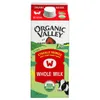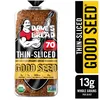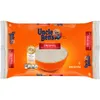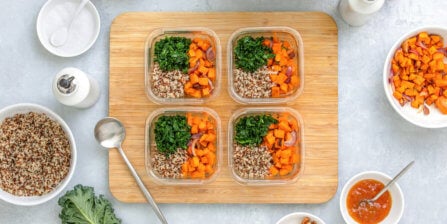Planning & Prep
Guide to Meal Kits vs. Groceries

Finding time to cook balanced and delicious meals in today’s fast-paced world is no easy feat. Meal kits and grocery shopping offer solutions for different lifestyles and preferences.
But should you choose meal kits vs. groceries?
Our guide will break down both options to help you find the cooking solution that suits your needs. Whether you’re a busy professional, a family with young children or simply looking to explore new culinary options, understanding the difference between meal kits and grocery shopping will help you with meal prep.
What are meal kits?
Meal kits offer a solution for those seeking to streamline their meal prep routine. By providing pre-portioned ingredients and step-by-step instructions, meal kits can reduce the time spent on cooking and planning meals. This is especially beneficial for busy individuals or families who struggle to find time for grocery shopping and meal preparation.
Meal kits offer a variety of cuisines and meal types, as well as the number of servings you need. This allows you to easily try new recipes without the hassle of extensive planning and ingredient sourcing.
Some meal kit services cater to various dietary restrictions, such as vegetarian, vegan, gluten-free and low-carb diets. This makes it easier for individuals with specific dietary needs to find convenient meal options.
Meal kits vs. groceries: Comparison

When comparing meal kits vs. groceries, it’s important to consider the trade-offs between convenience, cost, sustainability and lifestyle factors.
- Convenience vs. control: Meal kits offer convenience but may limit customization and control over ingredients. Whereas grocery shopping provides greater flexibility and allows individuals to choose their own ingredients and recipes, including romantic date nights at home.
- Lifestyle considerations: When comparing meal kits vs. groceries, it also depends on individual lifestyles, such as busy schedules, cooking skills and dietary preferences.
The best of both worlds: Combining meal kits and grocery shopping

While meal kits offer convenience, grocery shopping provides flexibility and control. A balanced approach can leverage the strengths of both options. Here are some ways to combine meal kits and grocery shopping:
- Weekday meals vs. weekend meals: Use meal kits or prepared foods for busy weekdays when your time is limited and grocery shop for weekend meals when you have more time to cook and experiment.
- Supplement meal kits with fresh produce: Enhance your meal kit meals with fresh produce from the grocery store, such as adding extra vegetables or fruits.
- Grocery shop for pantry staples: Stock up on pantry staples, like spices, oils and grains, at the grocery store and mix them in with your meal kit meals.
- Create your own meal kits: Use meal kits as recipe inspiration to create your own meals by purchasing ingredients from the grocery store.
- Seasonal produce: Incorporate seasonal produce from the grocery store into your meal kit meals for added flavor and freshness. For example, when it’s artichoke season, layer them into a lasagna or creamy dip.
By combining them, you can enjoy the convenience of meal kits while maintaining control over your ingredients with grocery shopping.
Grab it now on Instacart:










Benefits of meal kits and grocery shopping
When it comes to meal planning and prepping, it can be tough to choose between meal kits vs. groceries. Both options offer unique benefits and cater to different preferences. Here are a few benefits of each, as well as the benefits of combining both.
Benefits of meal kits
- Convenience: Meal kits have pre-portioned ingredients and step-by-step instructions to save time and effort.
- Variety: You have access to a wide range of cuisines and meal types.
- Portion control: Meal kits are pre-portioned to your desired amount of servings.
Benefits of grocery shopping
- Flexibility: Customize meals based on personal preferences and dietary restrictions.
- Ingredient control: Choose high-quality ingredients and control the freshness and source of produce with groceries.
- Cost-effectiveness: It can be more affordable in the long run, especially for frequent cooks and those who buy certain items, like grains, in bulk.
Combining the two
- Balanced approach: Leverage the strengths of both options for a personalized meal plan.
- Variety and convenience: Enjoy the convenience of meal kits and prepared foods while adding flexibility and customization with grocery shopping.
- Cost-effectiveness: Potentially save money by combining meal kits with grocery shopping for pantry staples and bulk purchases.
Tips for using meal kits and grocery shopping
Navigating the world of meal kits and effective grocery shopping isn’t easy. From choosing servings and customizing each meal, it’s no easy feat. Here are a few tips and tricks to help simplify the process.
Tips for using meal kits
- Plan ahead: Review the menu and plan your meals in advance to create your weekly meals.
- Follow instructions: Adhere to the instructions for best results and to avoid mistakes.
- Utilize leftovers: Plan for extra and repurpose your leftovers into new meals.
- Store properly: Store ingredients and prepared meals according to the instructions to maintain freshness.
- Customize your meals: Experiment with ingredient substitutions or additions to personalize your meals.
Tips for grocery shopping
- Meal planning: Create a meal plan based on your preferences and dietary needs for your weekly grocery trip.
- Make a list: Write down a grocery list to ensure you have everything you need.
- Buy in bulk: Purchase frequently used ingredients, like flour and sauces, in bulk to save money.
- Check expiration dates: Ensure that perishable items don’t expire in the next few days.
- Store properly: Store groceries correctly to maintain freshness and prevent spoilage.
Meal kits and groceries delivered to your door
Whether you opt for meal kits vs. groceries or combine the two, the key is to find an option that works for your lifestyle and preferences. By combining these two options, you can enjoy delicious and convenient meals while saving time and effort.
Ready to save even more time? Shop for groceries and prepared foods through Instacart. Simply create your account, browse and discover the items you need, and place your order today. With Instacart, you can enjoy the convenience of grocery home delivery without sacrificing quality, variety or convenience.
Most Recent in Planning & Prep

Planning & Prep
37 Care Package Ideas: From “Get Well” to “Just Because”
It’s always nice to show some extra appreciation for your loved ones. Whether you want to support a sick friend or a neighbor who had their first child, a care package is the perfect way…
Jan 30, 2025
Planning & Prep
Average Grocery Cost per Month: The 2025 Breakdown
The average grocery cost per month, per person, in the United States is roughly $350 for adults between 19 and 50 years old in a four-person household. This estimation depends on multiple factors, such as…
Dec 23, 2024
Planning & Prep
33 Shocking Global and National Food Waste Statistics (2025)
Did you know nearly 30% of the food produced globally is never eaten? This staggering food waste statistic highlights the alarming issue of uneaten food — a problem with environmental, economic and social consequences. Food…
Dec 23, 2024

 17 Grocery List Categories to Make Shopping Easy
17 Grocery List Categories to Make Shopping Easy  How to Meal Plan: Step-by-Step Guide to Meal Planning
How to Meal Plan: Step-by-Step Guide to Meal Planning  How To Read Food Labels: Guide to Nutrition Labels
How To Read Food Labels: Guide to Nutrition Labels 

